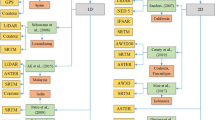Abstract
The study was conducted to model a 30-km section of the Kalpani River for flood inundation forecasting with the help of remote sensing, geographical information system (GIS), HEC-RAS (1D), and HEC-Geo RAS. 3D coordinates were extracted from ASTER 30 m digital elevation model (DEM). Model was simulated and calibrated for flood 2010 event of 1901 m3 s−1 (upstream) and 3361 m3 s−1 (downstream) on two parameters, i.e., contraction and expansion coefficients and Manning’s “n” values derived from the landuse map of the study area with the known water surface boundary condition. The average difference between known and computed water surface for model’s pre-calibration was 0.64 m, which was reduced in calibration up to 0.11 m. Calibrated model was then validated for flood 2006 event with known discharges, i.e., 1951 m3 s−1 (upstream) and 2285 m3 s−1 (downstream) with an average difference of 0.10 m between known and computed water surface. Calibrated model was further simulated with critical depth boundary conditions instead of known water surface boundary condition, which confirmed the earlier results of the same study. The model results revealed that the Kalpani River, passing through a flat topography of Mardan, with an average slope of 0.000786 m m−1 had a strong positive correlation coefficient of R 2 0.999 and 0.996 between the known and computed water surfaces for calibration and validation, respectively. Finally, the model was simulated for 5-, 10-, 20-, 50- and 100-year return periods with critical depth boundary condition. The risk maps of the study could not be produced owing to the coarser resolution of the DEM followed by area flatness, and river width flood inundation risk factors. It is therefore, suggested that the HEC-RAS model can be used for flood risk management and as decision support tool in the Kalpani River catchment.









Similar content being viewed by others
References
Colvocoresses AP (1982) An automated mapping satellite system (Mapsat). Photogrammetric Engineering and Remote Sensing. 48(10):1585–1591
Correia NF, Castro F, Da Graca M, Ramos I (1998) Coupling GIS with hydrologic and hydraulic flood modeling. Water Resources Management. 12(3):229–249
Dyhouse, G., J. Hatchett. and J. Benn. 2003. Floodplain modeling using HEC-RAS. Haestad Press, First Edition, Waterbury (USA). http://www.haestad.com/library/books/fmras/floodplainonlinebook/javascript/wwhelp/wwhimpl/java/html/wwhelp.htm (Accessed Mar 4 2007)
Hydraulic Engineering Center (HEC). 2010a. Reference manual. HEC-RAS Version 4.1. California, USA. http://www.hec.usace.army.mil/software/hec-ras/documents/HEC-RAS_4.1_Reference_Manual.pdf (Accessed on 13 June 2010)
Hydraulic Engineering Center (HEC). 2010b. User manual. HEC-GeoRAS Version 4.3. California, USA. http://www.hec.usace.army.mil/software/hec-ras/documents/HEC-GeoRAS_43_Users_Manual.pdf (Accessed on June 13, 2010)
Farooq M (2007) Flood modeling and simulations using hydrodynamic model and LIDAR DEM (a case study of River REM). Unpublished M.Sc Thesis, University of Applied Sciences Stuttgart, Germany
FEMA (2007). Guidelines and Standards for Flood Risk Analysis and Mapping. U.S. Department of Homeland Security, USA.
Fujisada, H. 1994. Overview of ASTER instrument on EOS-AM1 platform. Proceedings of SPIE, vol. 2268. The International Society for Optical Engineering: 14–36.
Irrigation and Power Department, Government of Khyber Pakhtunkhwa (2005) Ten year’s comprehensive flood protection plan Khyber Pakhtunkhwa. Unpublished, Peshawar, Pakistan
Khattak, M. S., F. Anwar., T. U. Saeed., M. Sharif., K. Sheraz. and A. Ahmed. 2015. Floodplain mapping using HEC-RAS and ArcGIS: a case study of Kabul River. Arabian Journal for Science and Engineering. http://link.springer.com/article/10.1007%2Fs13369-015-1915-3 (Accessed on 29 November, 2015)
Kute S, Kakad S, Bhoye V, Walunj A (2014) Flood modeling of River Godavari using HEC-RAS. Int J Res Eng Technol 03(09):81–87
May, D. R., A. Lopez. and L. Brown. 2000. Validation of the Hydraulic-Open Channel Flow Model HEC-RAS with Observed Data http://faculty.fortlewis.edu/may_d/dmay_homepage_support/Hecras%20Paper.DOC (Accessed on 25 May 2010)
Mehta DJ, Ramani M, Joshi M (2014) Application of 1-D HEC-RAS model in design of channels. Int J Innov Res Adv Eng (IJIRAE) 1(7):103–107
Patro S, Chatterjee C, Singh R, Raghuwanshi NS (2009) Flood inundation modeling using MIKE FLOOD and remote sensing data. J Indian Soci Remote Sens 37(1):107–118
Pender G, Neelz S (2007) Use of computer models of flood inundation to facilitate communication in flood risk management. Environ Hazards Risk Commun 7(2):106–111
Sinnakaudan, S. K. and S. H. Abu Bakar. 2005. Tight coupling of SFlood and ArcView GIS 3.2 for flood risk analysis. Geo-information for Disaster Management: 1413–1425.
Snead, Baldwin D (2000) Development and application of unsteady flood models using geographic information systems. Departmental Report, Master of Science in Engineering. the University of Texas at Austin, USA.
Traore VB, Sambou S, Sambou H, Diaw AT (2015) Steady flow simulation in Anambe River Basin using HEC-RAS. Int J Dev Res 5(07):4968–4979
Yang X, Grnlund A, Tanzilli S (2002) Predicting flood inundation and risk using geographic information system and hydrodynamic model. Inform world 8(1):48–57
Zerger A, Wealands S (2004) Beyond modeling: linking models with GIS for flood risk management. Nat Hazards 33(2):191–208
Acknowledgments
The authors would like to acknowledge SUPARCO, the National Space Agency, for providing SPOT satellite imagery, technical support, and guidance during the study as well as giving an opportunity for utilizing the SUPARCO lab for data analysis. Thanks are also extended to the US Corps of Engineering for free availability of HEC-RAS and HEC-GeoRAS Software on the Internet.
Author information
Authors and Affiliations
Corresponding author
Rights and permissions
About this article
Cite this article
Ullah, S., Farooq, M., Sarwar, T. et al. Flood modeling and simulations using hydrodynamic model and ASTER DEM—A case study of Kalpani River. Arab J Geosci 9, 439 (2016). https://doi.org/10.1007/s12517-016-2457-z
Received:
Accepted:
Published:
DOI: https://doi.org/10.1007/s12517-016-2457-z




